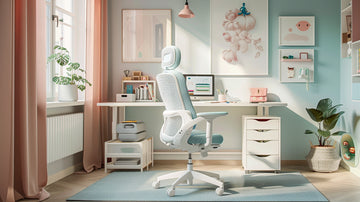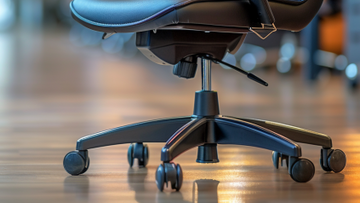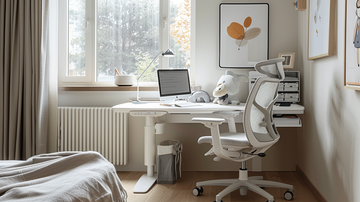Early History and Founding
Herman Miller was founded in 1905 in Zeeland, Michigan by Dirk Jan De Pree along with his father-in-law, Herman Miller. De Pree had purchased the Michigan Star Furniture Co. and renamed it after his father-in-law who had helped finance the purchase (Herman Miller).
The company originally produced high quality furniture and focused on classic reproductions. Some of their early innovations included the introduction of the authentic Colonial Revival style in the 1910s and the launching of their first steel furniture collection designed by Gilbert Rohde in the early 1930s (Herman Miller History: The Story of ... - Beverly Hills Chairs).
By the 1920s, Herman Miller was establishing itself as a leader in the American furniture industry with a focus on high quality, original designs.
Mid-20th Century Growth and New Leadership
In the mid-20th century, Herman Miller underwent significant leadership changes and business expansion. D.J. De Pree became president in 1943 after the death of company founder Dirk Jan De Pree. Under De Pree's leadership, Herman Miller began expanding beyond office furniture into new product categories like residential furniture. The company introduced several notable designs during this period, including the Marshmallow Sofa by Irving Harper in 1956 and the Eames Lounge Chair in 1956.
By 1960, the company had grown substantially and formally changed its name to Herman Miller, Inc. New manufacturing facilities were opened to increase production capabilities. According to the Herman Miller website timeline, "The company goes public in 1970, setting the course for rapid growth in the consumer channel" (https://www.hermanmiller.com/about/timeline/). This growth was facilitated by the leadership of Hugh De Pree, who became president in 1962 and CEO in 1980. The company expanded from a regional Michigan manufacturer to an international leader in modern furniture design and production.
The George Nelson Era
George Nelson joined Herman Miller as director of design in 1945, and would go on to have a profound impact on the company's direction and success over the next few decades. According to Herman Miller's company timeline, Nelson was the primary architect for their new Zeeland headquarters complex that began construction in 1950 https://www.hermanmiller.com/about/timeline/. His clean, modernist aesthetic helped define Herman Miller's image as a leading furniture designer.
Some of Nelson's most iconic Herman Miller designs include the Coconut Chair, the Marshmallow Sofa, and the Ball Clock. As described in an article on Herman Miller's website, the Nelson Bench he designed for his Fortune office "established a benchmark for modernity" with its sleek and minimalist style https://www.hermanmiller.com/stories/why-magazine/nelson-bench-design-history/. Nelson was an incredibly prolific designer - during his Herman Miller tenure he produced dozens of furniture pieces, lighting, textiles and more that embodied mid-century modern design.
Nelson's leadership and design vision at Herman Miller cemented the company as an arbiter of sophisticated, contemporary style. His modernist aesthetic and innovative sensibilities set the stage for further groundbreaking collaborations between Herman Miller and legendary designers like Charles and Ray Eames in the decades to come.
The Charles Eames Era
Charles Eames had a long and fruitful partnership with Herman Miller that led to the creation of some of the company's most iconic and influential designs. Eames first collaborated with Herman Miller in 1946 to produce molded plywood chairs, which became hugely successful. This demonstrated the company's willingness to experiment with new materials and production methods.
In 1956, Herman Miller began producing Eames' most famous design - the Eames Lounge Chair and Ottoman. The luxurious leather lounge chair exemplified the Eames' unique blend of innovation and comfort. According to Herman Miller, it became "an icon of American design".
The Eames Plastic Chair, created in 1950, also became an important part of Herman Miller's catalog. It was revolutionary in its use of molded plastic and fiberglass as chair materials. The chair's simple and compact design made it highly versatile and affordable.
The Eames designs, which exemplified mid century modern aesthetics, helped establish Herman Miller's reputation for combining design excellence with cutting-edge production techniques. They produced timeless, influential designs that incorporated new materials and emphasized comfort. The Eames legacy continues to be a vital part of Herman Miller's brand identity and ethos.
Expansion and Diversification in the 1970s-80s
The 1970s and 1980s were a period of major expansion and diversification for Herman Miller. Under the leadership of CEO Max De Pree, the company significantly grew its business and entered new product categories.
One key area of expansion was office seating. In 1974, Herman Miller acquired Westinghouse's office furniture division, which specialized in office chairs. This allowed Herman Miller to enter the market for task seating and expand beyond its focus on furnishings and modular office systems. In 1976, Herman Miller introduced the Ergon chair, one of the first ergonomically-designed office chairs. It featured innovations like seat angle adjustment and back height adjustment that would become standard in later office chairs (https://www.1stdibs.com/buy/herman-miller-1970s-chair/).
Herman Miller also diversified into healthcare furniture in this era. In 1978, the company acquired Action Office II, allowing it to enter the healthcare market. Throughout the 1980s, Herman Miller developed partnerships with healthcare providers to design and manufacture furniture for patient rooms, nursing stations, and other healthcare spaces.
The company expanded its offerings in high-end and specialty furnishings as well. In 1980, Herman Miller purchased Pollock Furniture, known for producing Art Deco reproductions. This allowed Herman Miller to diversify into luxury furnishings. The company also acquired Edelman Leather and Textiles in 1983, expanding its textiles business.
Through strategic growth and acquisitions in the 1970s and 1980s, Herman Miller transformed from primarily an office furniture company into a diverse, global leader in furnishings across sectors like healthcare, hospitality, and residential. The company's willingness to evolve positioned it for continued success into the 1990s and beyond.
The 1990s and dot-com Era
During the 1990s, Herman Miller faced challenges due to the economic recession but was able to rebound through strategic acquisitions and partnerships. The company acquired several office furniture manufacturers including Meridian, Integrated Metal Technology, and Brandrud Furniture. These acquisitions helped Herman Miller expand its capabilities and product offerings (https://www.hermanmiller.com/about/timeline/).
The rise of the dot-com industry and growth in office jobs provided new opportunities. Under the leadership of CEO Max De Pree, Herman Miller focused on developing ergonomic and flexible workstation systems designed for the evolving office environment. In 1999, the company introduced the Ethospace system which enabled custom configurations (https://en.wikipedia.org/wiki/Herman_Miller).
As the workforce became increasingly mobile, Herman Miller partnered with leading technology companies like Microsoft, Intel and Apple. The company's products adapted to support the needs of technology and knowledge workers who required flexible, reconfigurable and interactive workspaces.
2000s - Present Day
In the early 2000s, Herman Miller brought in Brian Walker as CEO to lead the company into the 21st century. Under Walker's leadership, Herman Miller focused on digital transformation, introducing technology-enabled products like the Live OS office system in 2021 which uses IoT sensors and machine learning to provide data-driven insights (1).
Some of Herman Miller's most notable products in recent years include the Embody chair designed by Bill Stumpf and Jeff Weber in 2009. Embody was the first work chair designed to provide proper ergonomic support while also stimulating blood and oxygen flow (2). In 2011, Herman Miller acquired a majority stake in Design Within Reach, a retailer specializing in modern design that helped Herman Miller expand its distribution network (3).
Today, Herman Miller remains one of the most influential and innovative furniture companies in the world. Under the leadership of President and CEO Andi Owen since 2018, Herman Miller continues releasing new designs, technologies, and partnerships across the office, healthcare, education, and home sectors (1). The company reported over $2.5 billion in net sales in 2021 and was named one of Fast Company's "Most Innovative Companies" (4). With over 100 years of history behind it, Herman Miller seems poised to keep designing the future of furniture.
Sources: (1) https://www.hermanmiller.com/about/timeline/ (2) https://slate.com/human-interest/2012/11/aeron-chair-history-herman-millers-office-staple-was-originally-designed-for-the-elderly.html (3) https://www.fastcompany.com/1671789/the-untold-history-of-how-the-aeron-chair-came-to-be/ (4) https://www.hermanmiller.com/about/Notable Product Designs
Herman Miller is known for its iconic and innovative furniture designs that have stood the test of time. Some of the most notable and recognizable Herman Miller products include:
The Eames Lounge Chair and Ottoman, designed in 1956 by Charles and Ray Eames, was called the "chair of the century" by the New York Times. Its molded plywood frame and leather cushions epitomize mid-century modern style. The chair balances comfort and sophistication and continues to be one of Herman Miller's most popular products (source).
The Aeron Chair, designed in 1994, revolutionized office seating with its patented PostureFit support and breathable mesh fabric. Designed to conform to the sitter's body, it set a new bar for ergonomics in task seating (source).
The Noguchi Table, designed in 1947 by Isamu Noguchi, is a sculptural wooden coffee table with two identical curved wood pieces forming the base. Lauded for its simplicity and beauty, it remains one of the most recognizable coffee table designs today (source).
These iconic designs demonstrate Herman Miller's leadership in modern furniture and commitment to both form and function. Many of their products display artistic expression combined with innovations in ergonomics and materials.
Impact and Legacy
Herman Miller has had an enormous impact on furniture design and is considered one of the most influential manufacturers in the industry's history.[1] The company pioneered the concept of modern office furniture and collaborated with some of the 20th century's most renowned designers such as Charles and Ray Eames, George Nelson, Isamu Noguchi, and Alexander Girard.
Notable awards and recognition for Herman Miller include winning the National Design Award for Corporate and Institutional Achievement from the Smithsonian's Cooper-Hewitt National Design Museum in 2003.[2] The company was also recognized by Fast Company as one of the most innovative companies in the world multiple times.
Herman Miller's place in design history is cemented through its iconic mid-century furniture pieces like the Eames Lounge Chair, the Noguchi Table, and the Aeron office chair. Even 100 years after its founding, Herman Miller continues to influence and drive innovation in furniture design today.[3]
The Future of Herman Miller
As Herman Miller looks to the future, the company remains focused on its vision of designing for the good of humankind. Herman Miller aims to continue anticipating and adapting to changes in how people work, live, heal, learn, and travel. The company is preparing for emerging trends like increased remote work, climate change, and a focus on mental health and wellbeing.
Herman Miller expects remote and hybrid work arrangements to become more prevalent in the years ahead. To address this, the company is developing products and solutions optimized for work from home environments. These include ergonomic furniture, tools for virtual collaboration, and services to help organizations transition to flexible work models. Herman Miller aims to enable people to work productively and comfortably wherever they are.
The company is also accounting for climate change and sustainability in its product development and business operations. Herman Miller has set ambitious environmental goals around carbon emissions, water use, and waste reduction. By designing products and systems focused on circularity, the company aims to reduce its ecological impact. Herman Miller is also exploring innovative materials and manufacturing processes to make its products more sustainable.
Additionally, Herman Miller recognizes the growing prioritization of mental health and wellbeing in society and the workplace. The company utilizes research-based insights around design's impact on emotional health to create restorative spaces that support users. With solutions focused on ergonomics, acoustics, nature integration, and more, Herman Miller aims to create environments that nurture human potential and foster a sense of belonging.
With its legacy of design leadership and human-centered approach, Herman Miller is poised to continue solving problems and enhancing lives through innovation. By staying attuned to emerging trends and needs, the company aims to keep making the future more livable, equitable, and sustainable for all.





